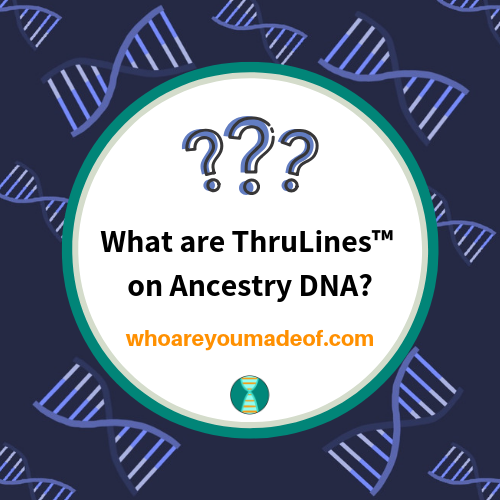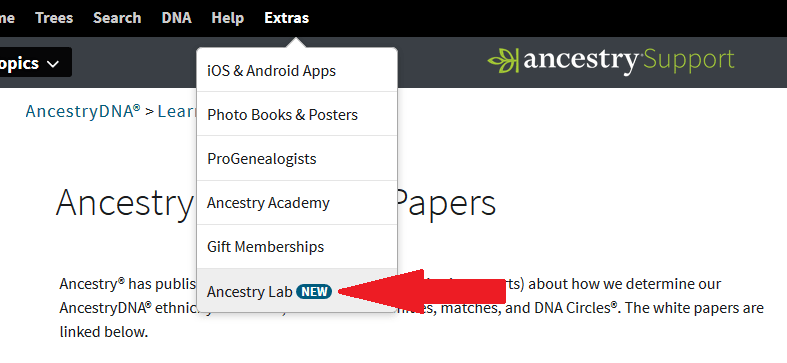If you haven't logged into your Ancestry DNA account recently, you might be missing some important discoveries about your family tree. Along with a regularly updated DNA match list, Ancestry DNA offers the ThruLines™ feature.
ThruLines is an easy way to tell through which ancestor you and your DNA matches are related.
In this post, you'll learn:
- What kind of information you can expect to learn from ThruLines
- How to activate ThruLines on your Ancestry account
- Advantages of using ThruLines
- What to do with the information learned through Ancestry DNA ThruLines

When this feature was released a couple of years ago, I could hardly breathe from the excitement. This might sound dramatic, but I am not exaggerating when I say that this feature has saved an incredible amount of time and effort researching connections.
What can ThruLines on Ancestry tell you?
ThruLines can help you find out how you are related to some of your DNA matches. If you and your DNA match both have a family tree, Ancestry can leverage the power of its software and millions of public family trees in order to determine through which ancestor you are connected.
Using the same technology, Ancestry's new ThruLines feature can suggest new potential ancestors - people who you don't already have in your tree.
Are ThruLines the same as Common Ancestor Hints?
Common Ancestor Hints are a great tool, and they save a lot of time scrolling through family trees. ThruLines uses the same technology as Common Ancestor Hints, but your ThruLines are displayed using a unique interface that allows you to visualize the paths through which you and multiple matches are connected.
Common Ancestor Hints are for viewing individual DNA matches, while ThruLines can help you figure out how you are related to several matches at once.
This is a very powerful difference that can save a lot of time and help you form new conclusions.
How to access ThruLines on Ancestry DNA
As of February 27, 2019, the ThruLines feature is available as a beta feature through the Ancestry Lab. Click on the "Extras" tab from your main dashboard, and then click Ancestry Lab.
You'll be prompted to activate the ThruLines feature, and then you will be able to access your DNA Insights main page to see your ThruLines. They'll appear where your DNA Circles were, since the Ancestry ThruLines feature has replaced DNA Circles.

How to understand Ancestry ThruLines
Most of our DNA matches are descended from siblings of our ancestors, and it is very difficult to know or research all of these different lines of our tree. Ancestry is able to do the "heavy lifting" for us and automatically build our family trees, and those of our matches, back a few generations to find the common ancestor.
I have a quick example that shows the power (... magic?) of this tool.
My dad's great-great-great-great grandfather was named Christjaan. He was born in Holland, and I don't have access to excellent records. I only knew the name of my direct ancestor who is the child of Christjaan, his son named Eltje.
When I clicked on Christjaan's name on my dad's ThruLines, I realized that Christjaan had at least two more children, and their names were Trijntje and Harm. If you traced Trijntje's line down five generations, you would find my DNA match "Abe".
If I click the little down arrow under Trijntje's name, it will expand and provide me with all of the names of Abe's ancestors leading back to Trijntje.
Abe is my dad's 5th cousin once-removed, and they share 9 centimorgnas of DNA. This is within the range of "normal" shared DNA for cousins of this distance.

Where did Ancestry get this information? Fortunately, they tell us right on this screen. In the case of Trijntje, I can see that the information came from a person who is not my DNA match. I greyed out their screen name for privacy. Harm's information comes from the family tree of my DNA match, Ray.
There might be useful information about your ancestors contained in a family tree of an Ancestry user who is not a DNA match to you (we don't share DNA with all of our relatives), or who hasn't tested.
The people who are outlined with a dotted line are not currently in my tree, and those who are in a white box with a solid outline are already in my tree.
Advantages of ThruLines
There are several advantages that I've spotted just after using the feature for one day:
- I spend time building family trees for my matches to figure out how we are related. I don't have to do this any more with certain matches on Ancestry. Sweet!
- Did you notice my dad's 4th great-uncle, Harm, on the example above? I can now research him and his sister, Trijntje, in order to learn more about my dad's family. Where they lived, who they lived with, and other important facts might lead me to discover details about Christjaan, and maybe even Christjaan's parents.
What to do with information learned through ThruLines
What should we do with the information that we learn from ThruLines on Ancestry? I've got a few ideas.
Check to see how much DNA shared with matches identified through ThruLines
It's possible to be related to DNA matches in more than one way, and so I'll carefully check the amount of shared DNA that I share with my matches in order to see if shared DNA lines up with the relationship identified through this tool.
Verify information learned from ThruLines using documents and records
Even though this feature is incredibly exciting and has the potential to save us a ton of work, I think it is important to always double-check information that we learn through this tool.
For example, I am going to spend some time searching for documents and other records that verify that Trijntje and Harm are, indeed, children of my ancestor, Christjaan.
Add new lines and descendants discovered through ThruLines to family tree
I love building a complete "wide" family tree, and I try to add everyone possible. This helps me in identifying DNA matches in the future, and should help my descendants and other family members learn about their family tree someday.
Once I have verified my relationship to all of the descendants of Trijntje and Harm, I will add them to my tree. This includes Ray and Abe, my dad's DNA matches.
Haven't tested with Ancestry DNA?
Do you want to see if Ancestry DNA can help you learn more about your ancestors with the ThruLines feature? You'll need to test with Ancestry first. If you already tested, you can already access to tool using the instructions above.
Conclusion
I hope that this post has given you a good idea of what Ancestry DNA's ThruLines feature can help you learn about your family tree. As you can probably tell, I really love this idea. If you check it out for yourself, I would love to hear what you learned in the discussion below.
Thanks for stopping by!


Patrice
Wednesday 31st of January 2024
Lately I've been adding people to my tree through DNA matches. In ThruLines I had 30 matches under my 2nd great grandfather William. For some reason he's now a duplicate under ThruLines as my 2nd great granduncle and those DNA matches are divided as 25 under great grandfather and 6 under great granduncle (one extra now). He's not a duplicate on my tree where his relationship to me still shows correctly. Under ThruLines his son Joseph remains as my great grandfather but his son John is now showing as my 1st cousin 3X removed rather than a great granduncle per my tree. The one DNA match through John is my 3rd cousin David and I've updated that on ThruLines but it still puts him as a 4th cousin on the relationship comparison list and that whole line up to uncle John is incorrect. I also know it's not David's tree that's messing this up as he only has 7 people on it. How can I fix this or even understand why it's doing this?
Pat G.
Sunday 27th of February 2022
I think it is important for readers to know Thru Lines is NOT 100% accurate. I have a Thru-Line to my third great-grandfather which is totally undocumented. It was apparently arrived at by someone on Ancestry who added the person to their tree without documentation. Very dangerous!
Mercedes
Sunday 27th of February 2022
Hi Pat! Yes, you are correct in that it is possible for ThruLines to incorrectly show ancestors. I will update this post and link to an article that I have written that addresses this exact issue. Thank you for mentioning this. Sincerely, Mercedes
Kim G.
Wednesday 6th of May 2020
Hello, I hope you see this comment. I've been using Thru Lines for a while now, along with the DNA matches. A while back I began to suspect that my maternal grandfather was not actually my biological grandfather. This because my supposed first cousin (mom's sister's daughter) was a DNA match to grandfather's sister's son but I was not. I had a match with close cM's to what I shared with my cousin, but the match was identified by initials with the account manager's name listed. Upon investigation, I determined the biological family my mother belonged to but not the specific individual. I was able to contact the account manager with my finding, but he wasn't aware of any indiscretions. His father is living but older and ill, and he said this would be a sensitive matter to his father so would have to find the right time to broach the subject. I have been testing out the various family members in my tree to try to determine which relationship fits best percentage wise with relationships to the other family matches. I think I might have narrowed it down to the correct person and have listed him as my grandfather in my tree. My issue is that Thru Lines shows that I have no common matches to him, but this is not true. I know of two matches that descend from him, and they show up in Thru Lines under his name but under his father's matches. Additionally, he shows up twice there, both as my grandfather and as my great uncle. I've never seen that before. Any idea why he's showing up twice and how to fix it? I've checked the relationships and they look good. I have emailed Ancestry but haven't received a reply. I also tried Ancestry Chat and didn't get through. Any suggestions would be appreciated.